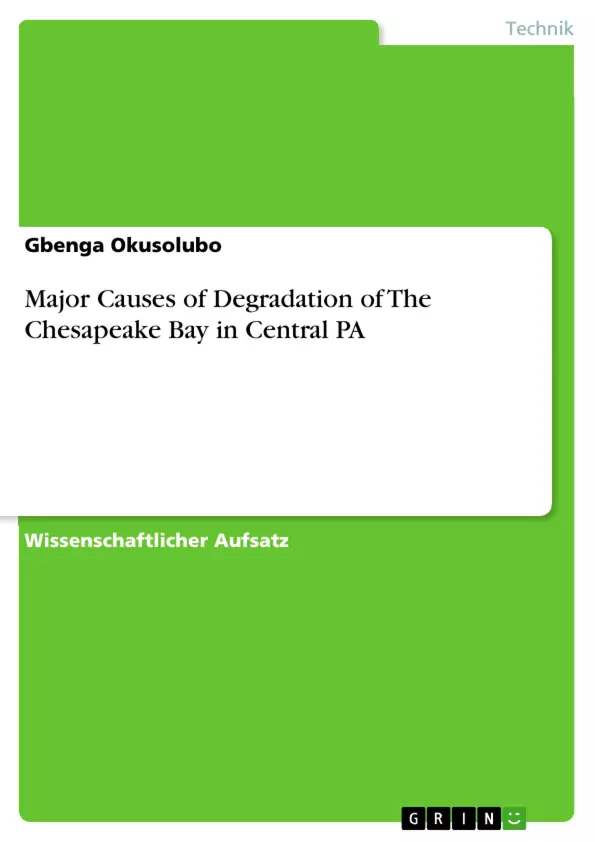According to the Federal Leadership Committee for Chesapeake Bay (2010), the lives and livelihoods of 17 million people and 3,600 species of plants and animals are intertwined with the beautiful landscapes and winding waterways, with the rural communities and urban centers. The Chesapeake Bay provides important habitat for many marine species and migratory birds using the Atlantic flyway (USGS Chesapeake Bay Plan). These species, including oysters, depends on the quality of the water to feed and reproduce. The key species that influences the water quality in the Bay is the Easter Oyster (Osborne 1999). The Chesapeake Bay hold more than 15 trillion gallons of water and is fed by 50 major tributaries (or streams and rivers) every day the largest of these are the Susquehanna, Potomac, Rappahannock, York, and James (Chesapeake Bay Foundation, 2010).
Inhaltsverzeichnis
- Einführung
- Faktoren, die maßgeblich zur Verschlechterung der Chesapeake Bay in Central PA beitragen
- Bevölkerungswachstum
- Landwirtschaftliche Verschmutzung
- Erosion
- Schlussfolgerung
Zielsetzung und Themenschwerpunkte
Dieser Text analysiert die Hauptursachen für die Verschlechterung der Chesapeake Bay, insbesondere in den zentralen Regionen Pennsylvanias. Er untersucht die Auswirkungen von Bevölkerungswachstum, landwirtschaftlichen Praktiken und Erosion auf die Wasserqualität der Bucht.
- Die Auswirkungen von Bevölkerungswachstum auf die Verschmutzung der Chesapeake Bay
- Die Rolle der Landwirtschaft bei der Verschlechterung der Wasserqualität
- Die Bedeutung von Erosion und Sedimentation für die Gesundheit der Chesapeake Bay
- Die Bedeutung des Schutzes der Chesapeake Bay und ihrer Ökosysteme
- Die Herausforderungen bei der Bewältigung der Verschmutzung und Wiederherstellung der Bucht
Zusammenfassung der Kapitel
Einführung
Die Chesapeake Bay ist das größte und einst produktivste Ästuar Amerikas. Seit der Kolonialzeit dient sie als Quelle für wirtschaftliche Ressourcen. Der Text beschreibt die Bedeutung der Bucht für die Fischerei, den Lebensraum für Wildtiere und die Erholung. Er führt die wichtigsten Faktoren ein, die zur Verschlechterung der Bucht beitragen, und betont die Rolle des Susquehanna River als einer der Hauptzuflüsse.
Faktoren, die maßgeblich zur Verschlechterung der Chesapeake Bay in Central PA beitragen
Bevölkerungswachstum
Der Text untersucht die Auswirkungen des Bevölkerungswachstums in Central PA auf die Verschmutzung der Chesapeake Bay. Er erläutert, wie die Zunahme der Bevölkerung zu mehr Abwasser, Landnutzungsänderungen und erhöhtem Abfluss führt, was die Wasserqualität beeinträchtigt.
Landwirtschaftliche Verschmutzung
Der Text hebt die Bedeutung der Landwirtschaft als Quelle der Verschmutzung hervor. Er diskutiert die Auswirkungen von Düngemitteln, tierischen Abfällen und Bewässerungspraktiken auf die Nährstoffbelastung der Bucht und die Entstehung von Algenblüten.
Erosion
Der Text beschreibt die Rolle der Erosion in der Susquehanna River-Region und die Auswirkungen auf die Sedimentation in der Chesapeake Bay. Er erklärt, wie Erosion die Wasserqualität beeinträchtigt und die Lebensräume von Wassertieren verändert.
Schlüsselwörter
Chesapeake Bay, Verschlechterung, Bevölkerungswachstum, landwirtschaftliche Verschmutzung, Erosion, Nährstoffe, Algenblüten, Sedimentation, Wasserqualität, Susquehanna River, Central PA
- Quote paper
- Gbenga Okusolubo (Author), 2017, Major Causes of Degradation of The Chesapeake Bay in Central PA, Munich, GRIN Verlag, https://www.grin.com/document/414073



